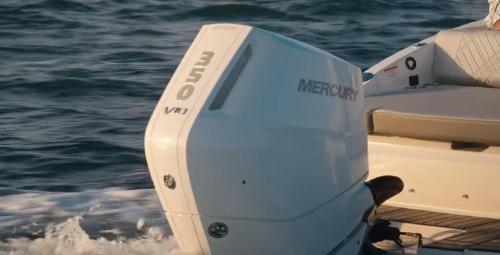Cox Marine’s CXO300 and CXO350 outboard diesel engines offer an impressive blend of power, fuel efficiency, and durability—engineered specifically for the rigorous demands of commercial vessels and the performance needs of luxury tenders and RIBs. These engines are reshaping what boaters expect from diesel propulsion, with automotive-level engineering and a mission to offer a true alternative to traditional gas outboards.
A New Breed of Diesel Outboards
Cox Marine, a UK-based company, set out to do something few have attempted: build an entirely new outboard engine platform from the ground up—designed specifically for diesel fuel. Unlike many diesel marine engines that derive from truck or industrial blocks, the CXO300 and CXO350 are purpose-built marine engines that prioritize torque, longevity, and safety at sea.
While the CXO300 is already in production and being used around the world, the CXO350—announced in 2023—is expected to begin production in 2025, building on the same architecture with greater power.
Key Differences Between the CXO300 and CXO350
| Feature | CXO300 | CXO350 |
|---|---|---|
| Power Output | 300 hp (224 kW) | 350 hp (261 kW) |
| Engine Displacement | 4.4L V8, twin-turbo diesel | 4.4L V8, twin-turbo diesel |
| Max Torque | 479 lb-ft (650 Nm) @ 2250 rpm | 556 lb-ft (754 Nm) @ 2500 rpm |
| Dry Weight | 866 lbs (393 kg) | 866 lbs (393 kg) |
| Fuel Type | Diesel (EN590 / ASTM D975) | Diesel (EN590 / ASTM D975) |
| Emissions Compliance | EPA Tier 3, RCD II, IMO II | Expected to meet same standards |
| Availability | In production | Expected 2025 |
Why Diesel?
For many operators, especially in commercial fleets and military applications, diesel has long been the standard due to its greater energy density, lower volatility, and superior fuel economy. These benefits are now being transferred to outboards thanks to Cox’s engineering.
Key advantages include:
- 30%+ better fuel efficiency compared to gas outboards at cruise
- Longer service intervals (up to 250 hours vs. 100 for many gas engines)
- Up to 3x longer lifespan, with projected 3,000+ hours of operational life
- No need to store gasoline on diesel-only vessels
- Better torque at low RPM, ideal for heavy or planing boats
This makes the CXO line ideal for government patrol boats, commercial fishing vessels, passenger transport, and tenders on superyachts already running diesel.
Fuel Efficiency and Range

Independent testing has confirmed that the CXO300 can reduce fuel burn by as much as 30–35% at cruising speed when compared to equivalent gasoline outboards like the Yamaha 300 or Mercury Verado 300.
For example:
- CXO300 fuel burn: ~15.8 GPH (60 LPH) @ 3500 rpm
- Gas equivalent (Yamaha F300): ~23.5 GPH (89 LPH) @ 3500 rpm
For commercial operators running 500–1,000 hours a year, this difference translates into thousands of dollars saved annually, not to mention longer range and reduced refueling stops.
Cost and Pricing
While pricing can vary by dealer and installation, typical base prices are:
- CXO300: ~$58,000 USD / ~$78,000 CAD
- CXO350: Expected ~$65,000 USD / ~$87,000 CAD
These prices are significantly higher than gas outboards, but Cox argues that lower fuel costs, reduced maintenance, and longer lifespan close the total cost of ownership gap within just a few years—especially for high-usage applications.
Disclaimer: Prices are estimates based on manufacturer and dealer data as of 2025. Final pricing will vary by location, taxes, options, and installation requirements.
Service and Maintenance
One of Cox’s core selling points is serviceability and long-term support. The engines are designed with automotive-style diagnostics and modular components to reduce labor time. Key maintenance notes:
- Oil changes every 250 hours
- Dry sump lubrication keeps engine height low and improves reliability
- Hydraulic valve lifters eliminate the need for valve lash adjustments
- Saltwater-ready materials including stainless steel and hard-anodized parts
Cox is continuing to grow its global service network, with support hubs in the U.S., Canada, Europe, Middle East, and Asia-Pacific.
Applications

You’ll find the CXO300 on a range of vessels where torque, range, and diesel compatibility are vital:
- Rigid Inflatable Boats (RIBs)
- Military patrol boats
- Law enforcement vessels
- Superyacht tenders
- Offshore fishing boats
- Oil & gas platform support boats
With the CXO350, even larger and faster vessels can enjoy the same diesel benefits with improved top-end performance and acceleration.
Looking Ahead: The CXO350
Announced as the next step in Cox’s evolution, the CXO350 increases torque and horsepower by ~17% while maintaining the same engine platform. This means existing users can upgrade with no change to rigging, weight, or transom configuration.
Sea trials are underway, and the CXO350 is expected to be especially appealing for:
- Heavy, twin- or triple-outboard offshore boats
- Luxury tenders requiring more speed
- Government or rescue craft operating in heavy seas
The increase in torque—up to 556 lb-ft—means the CXO350 can push bigger loads more efficiently while maintaining the benefits of diesel propulsion.
Final Thoughts
The Cox CXO300 and CXO350 represent a paradigm shift in the outboard engine market. They aren’t trying to compete directly with recreational gas engines on price or weight—instead, they serve operators who need efficiency, range, torque, and reliability in a diesel-compatible package.
As more boaters and commercial operators seek alternative propulsion options, particularly where gas is either unsafe or impractical, Cox Marine is quickly carving out a niche that could become the new standard in many fleets.
If you operate a commercial vessel, tender, or offshore boat and are looking to optimize for diesel-only fuel systems, reduce downtime, and improve operating margins, the CXO300 and CXO350 are well worth a closer look.


Use the share button below if you liked it.